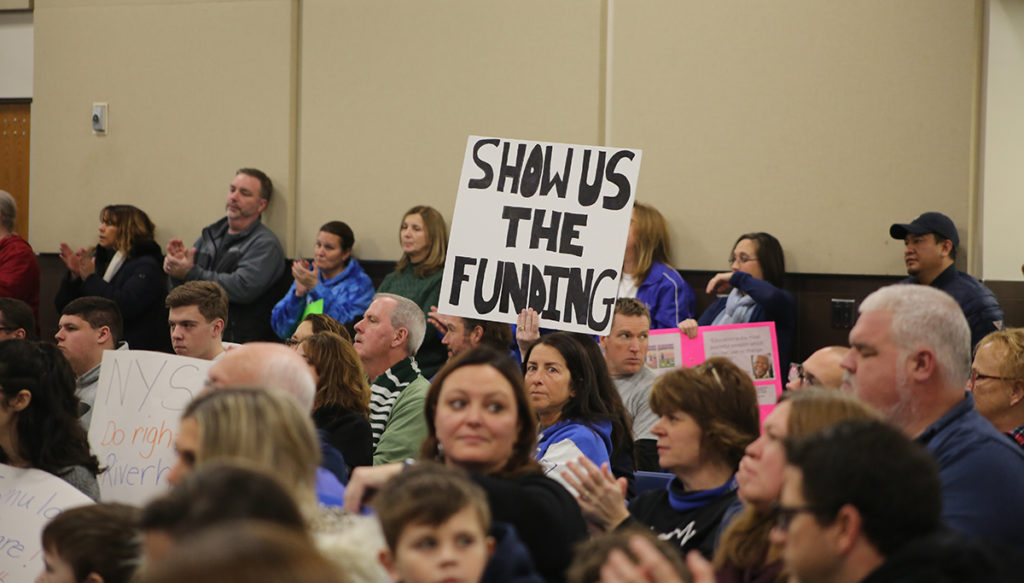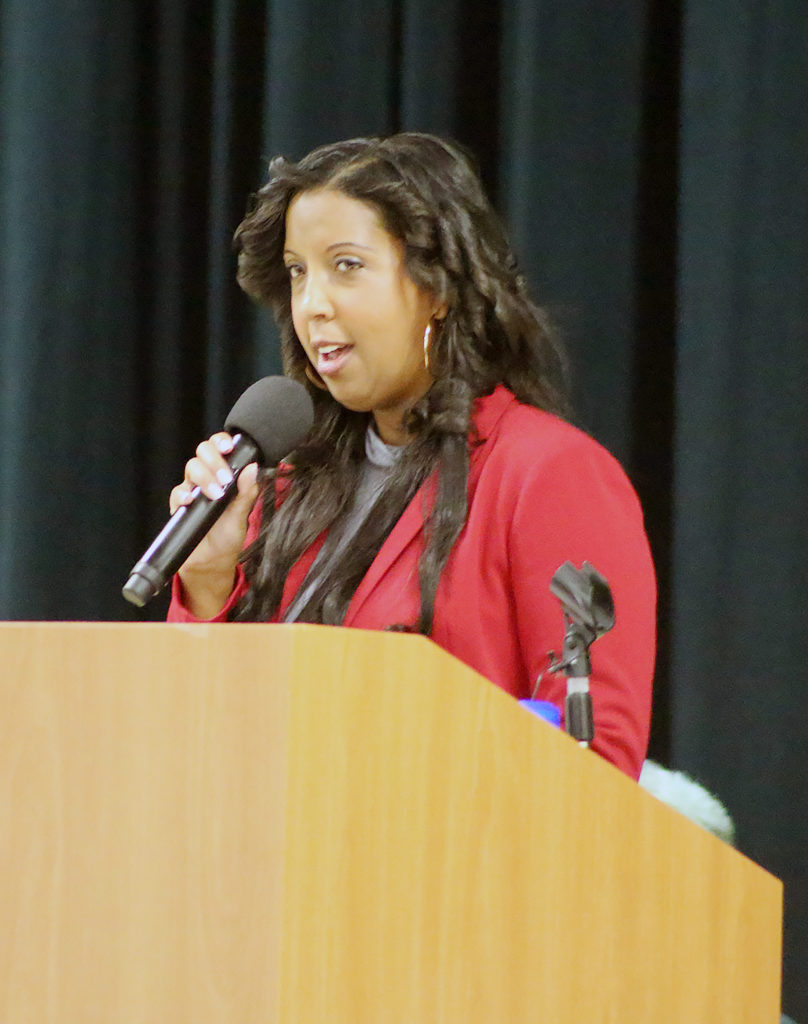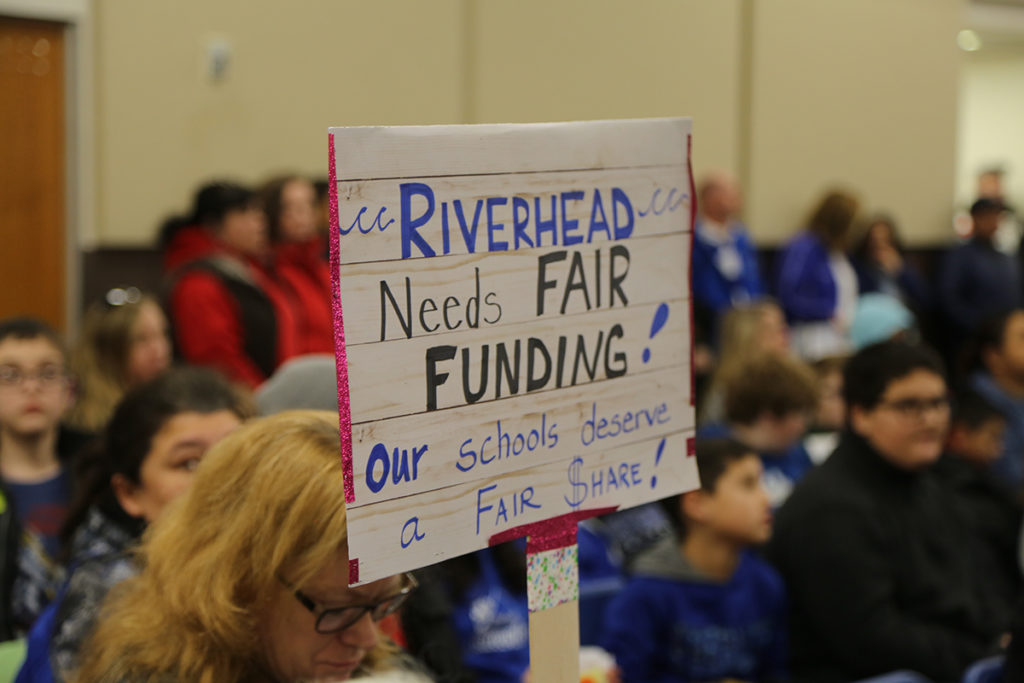Hundreds plead for state aid owed to school district at rally in Riverhead

Hundreds of voices chanted “Fair share now!” in unison as students, parents, teachers and elected officials rallied to fight for additional state aid in Riverhead Saturday.
“The time has come for Riverhead to join together and fight for our school district and fight for our children,” Superintendent Dr. Aurelia Henriquez said, addressing a fired-up crowd in the Riverhead Middle School cafeteria. “We are just getting started.”
Riverhead is the latest district to join a statewide push for more aid, calling on lawmakers to fully fund what’s known as Foundation Aid.
First enacted in 2007, Foundation Aid is the “largest unrestricted aid category supporting public school district expenditures in New York State,” according to state Department of Education officials. It was meant to give public schools a $5.5 billion spending boost through 2011, but the Recession delayed many of those payments. Since the 2008-2009 school year, it has only been partially funded and now, billions of dollars in aid are owed to hundreds of schools across New York.
According to board of education president Greg Meyer, Riverhead has only received around $17 million of the $48 million the district is entitled to.
The $31 million shortfall, he said, is harming students.

“The reputation of [Long Island] as one of the wealthiest parts of the state does a disservice to the needs of the increasing number of districts below the state average in wealth and needs of the students who live in them,” Mr. Meyer said.
According to data compiled by the Alliance for Quality Education New York (AQE), Riverhead is owed $31,159,786 in foundation aid—that’s over $5,000 per student currently enrolled in the district.

Other nearby districts are owed less—$1,959,885 is owed to Shoreham-Wading River and Greenport is owed $616,429—while other districts, such as Mattituck and Southold are owed nothing.
“We need to level the playing field,” Riverhead Town Supervisor Yvette Aguiar said, questioning why many neighboring districts are not owed anything. “If the money doesn’t come to us, we’re going to go out and get it,” she continued, vowing to fight in Albany and even Washington D.C. for increased aid.
Riverhead, Glen Cove City School District, Port Chester-Rye Union Free School District, Ossining Union Free School District and Westbury School District are part of a coalition called the “Harmed Suburban Five” that have received the lowest percentage of what they’re owed.
Dr. Henriquez said that Riverhead receives less than 50% of its allocated aid.
It’s time for lawmakers in Albany to hear our cries for help.
Catherine Kent
“Our fair share of funding will allow us to hire teachers, counselors and much needed staff,” she said. “We would be able to afford things like a nine period day and a desperately needed alternative school. These are things that many other districts are able to provide. All of our children deserve the same.”
Based on the AQE analysis, Brentwood and Central Islip are the Long Island districts owed the most aid—$142,241,195 and $62,233,674, respectively.
Funding levels vary between districts and shift year to year, but are based on a complex formula that’s based on the cost to educate each student, costs of living and other demographic data.
Critics of the formula, including Gov. Andrew Cuomo, have advocated to create a new formula to calculate aid. In his State of the State and budget address in 2019, Mr. Cuomo proposed a requirement that would direct districts to spend money to address needs its poorest schools in their district first. Mr. Cuomo is expected to release his 2020 budget Tuesday and district officials are hoping for a more equal share of aid.
“Over the next few months, our state senator and assemblymen are going to be haggling with their colleagues to help get our fair share,” deputy superintendent Sam Schneider said. “I hope those legislative leaders remember this district needs its fair share of assistance. The boys and girls in the crowd today deserve it.”
Assemblyman Anthony Palumbo (R-New Suffolk) did not respond to a phone call Friday.

The Riverhead Board of Education will ask voters next month to vote on a $96.5 million capital bond project to mitigate issues created by schools now facing maximum enrollment.
Amy Bailey of Jamesport, who attended the rally with two of her daughters, said in an interview that she would be supporting the bond.
“People aren’t seeing the big picture and how it will impact [students,]” she said.
Her daughter Aela, a freshman, described the overcrowding firsthand.
“The kids refer to the way we walk in the hallway as the penguin walk,” she said. “There’s literally no room.”
Since 2008, the district has seen a 22.8% increase in student enrollment and a 307.9% increase in the number of English language learners. Nearly 50% of all students in the district receive free or reduced-price lunch.
Riverhead Central Faculty Association President Greg Wallace said the influx of students with specialized needs puts a strain on all faculty and staff. He announced that later this month, New York State United Teachers president Andy Pallotta would be visiting Riverhead schools as part of his “Fund Our Future” bus tour that spotlights how a lack of school funding has impacted students.
Councilwoman Catherine Kent, who worked as a teacher in the Riverhead district for 33 years, said Riverhead is continually short-changed in aid—but that the need is more dire than ever.
“It’s time for lawmakers in Albany to hear our cries for help and garner the courage necessary to level the playing field,” she said.
Corrections: Sam Schneider is the deputy superintendent, not assistant superintendent. A quote attributed to Mr. Schneider should have said “assemblymen,” not “assemblyman.” Riverhead officials took exception to a line saying school conditions have deteriorated, arguing that the increased population does not equal deteriorated conditions.








